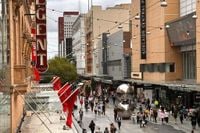Australia is poised for a significant shift in its monetary policy as the Reserve Bank of Australia (RBA) prepares for a potential interest rate cut in May 2025. This anticipated change comes on the heels of a noticeable drop in inflation rates across the country, particularly in Adelaide, where the Consumer Price Index (CPI) has shown a remarkable decline.
Published on April 30, 2025, the analysis reveals that underlying inflation nationally has decreased to 2.9 percent on an annual basis, while Adelaide's inflation has fallen to 2.2 percent for the year ending in March 2025. This drop marks a shift from a previous rate of 2.5 percent recorded for the year to December. BDO Economics partner Anders Magnusson noted that this decline in Adelaide's inflation ends a long-term pattern where the city consistently recorded annual CPI growth above the national average since June 2022. “The drop to 2.2 percent in the March quarter ended this pattern,” Magnusson stated.
As the RBA gears up for its May meeting, the consensus among economists has solidified around the expectation of a 25 basis point rate cut, which would lower the cash interest rate to 3.85 percent. Analysts from major financial institutions, including CBA, ANZ, and Westpac, all predict this cut, which would be the first adjustment since the bank's previous adjustments aimed at controlling inflation.
Nationally, Australia’s CPI continues its downward trajectory, with headline inflation remaining steady at 2.4 percent and underlying inflation dipping below the critical 3.0 percent mark for the first time since the onset of the COVID-19 pandemic. The trimmed mean, which is the RBA’s preferred measure of inflation, grew by 0.7 percent in the March quarter, contributing to the annual figure falling below three percent for the first time since December 2021. This measure excludes items with volatile price changes, providing a clearer picture of inflation trends.
Magnusson emphasized that the historical data surrounding inflation prior to the tariff wars initiated by former US President Donald Trump provides sufficient evidence for the RBA to consider a rate cut. He elaborated, “While the historical data looks at the months before Trump’s tariff war, it alone provides sufficient evidence for the RBA to cut the cash rate by 25 basis points in their May board meeting.”
The implications of a reduced cash rate are significant, particularly for South Australian households. Magnusson pointed out that lower interest rates could lead to increased disposable income, which in turn could boost consumer demand and spending. This would be particularly beneficial for business investment and economic growth in the region.
In a recent report, the CommSec State of the States highlighted that South Australia has slipped from equal second to fourth position on the economic leaderboard, hindered by lower rankings in economic growth, equipment investment, and relative population growth. However, the report also noted that South Australia experienced the second highest annual increase in home prices through March 2025. Magnusson assured that the anticipated cash rate cut may have a smaller local price impact than in other states, given Adelaide’s unique housing market dynamics.
Despite the positive signals from inflation data, Magnusson cautioned that a reduced forecast for economic growth poses challenges for domestic inflation and the RBA’s next cash rate decision. “Slower growth would take some heat out of the economy, reducing inflation, and prompting the RBA to be more resolute about reducing the cash rate in May,” he explained.
Moreover, the labour market in Australia remains robust, which has helped mitigate fears of wage-induced inflation. Magnusson noted that services inflation, heavily reliant on labor, has reached its lowest annual increase since the June 2022 quarter, providing the RBA with some breathing room regarding its monetary policy.
With these developments, the RBA is faced with a crucial decision that could shape the economic landscape of Australia for the remainder of the year. As the central bank prepares to convene, all eyes will be on its policy announcements and the potential ripple effects on consumers and businesses alike.
In summary, the combination of falling inflation rates, expectations for a cash rate cut, and a resilient labor market presents a complex but promising economic scenario for Australia. As the RBA approaches its May meeting, the focus will undoubtedly remain on how these factors will influence its monetary policy decisions moving forward.




